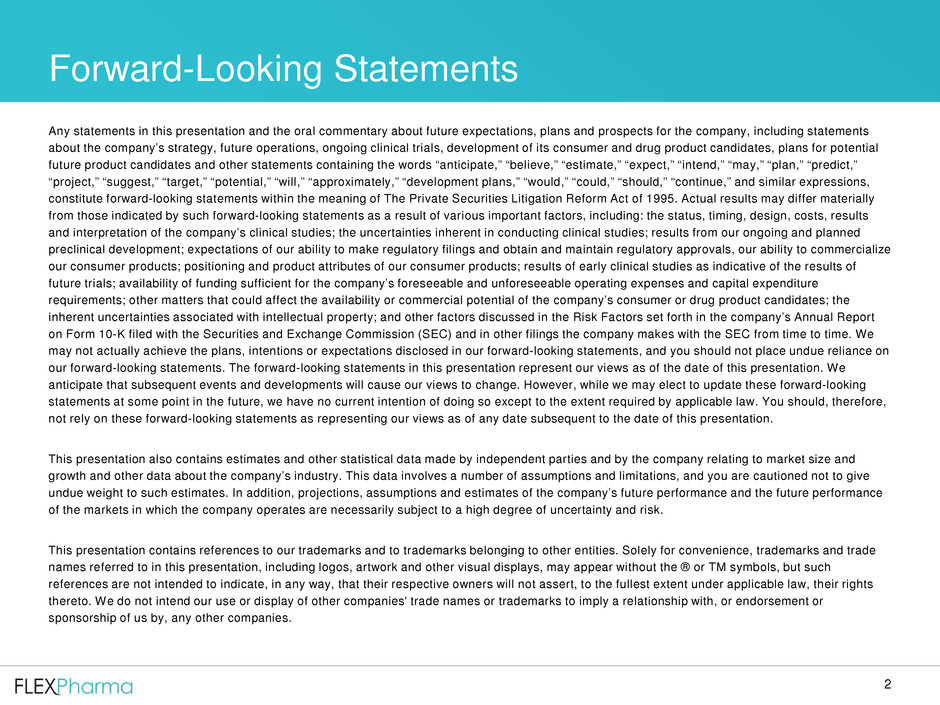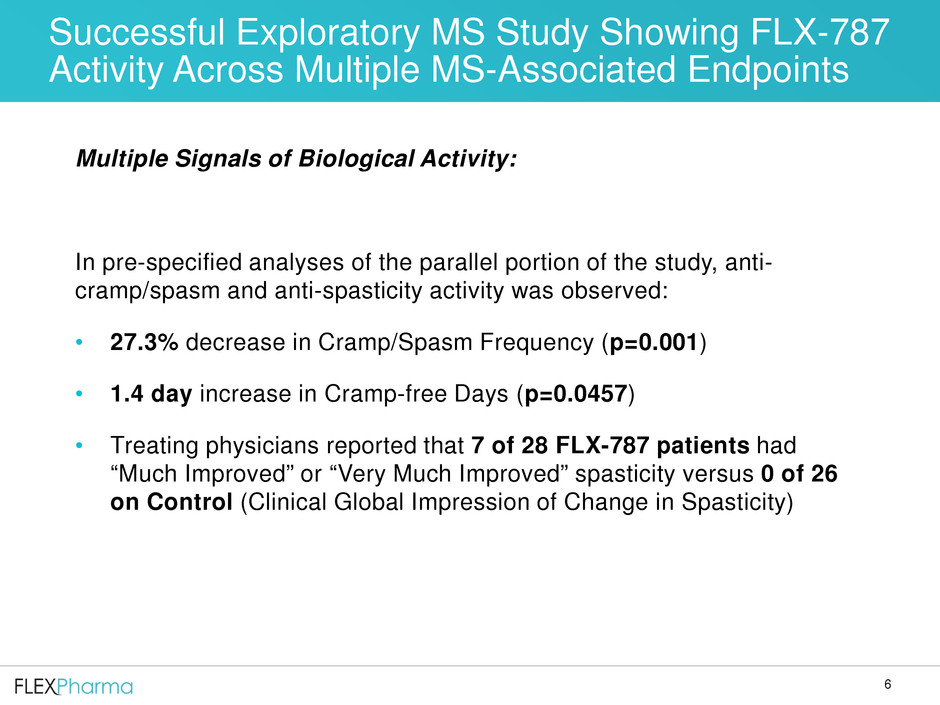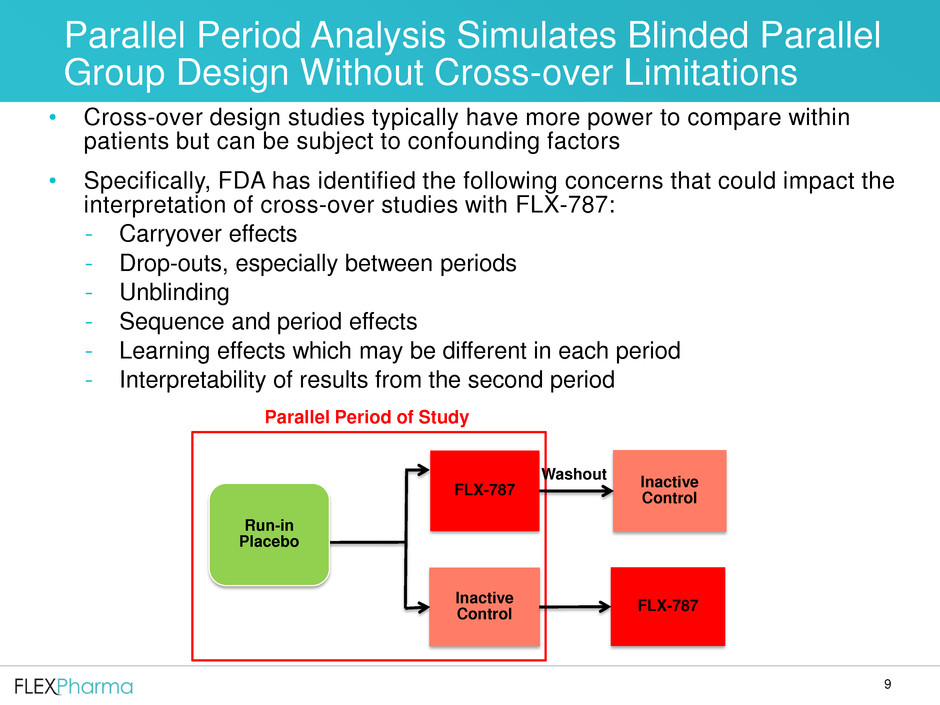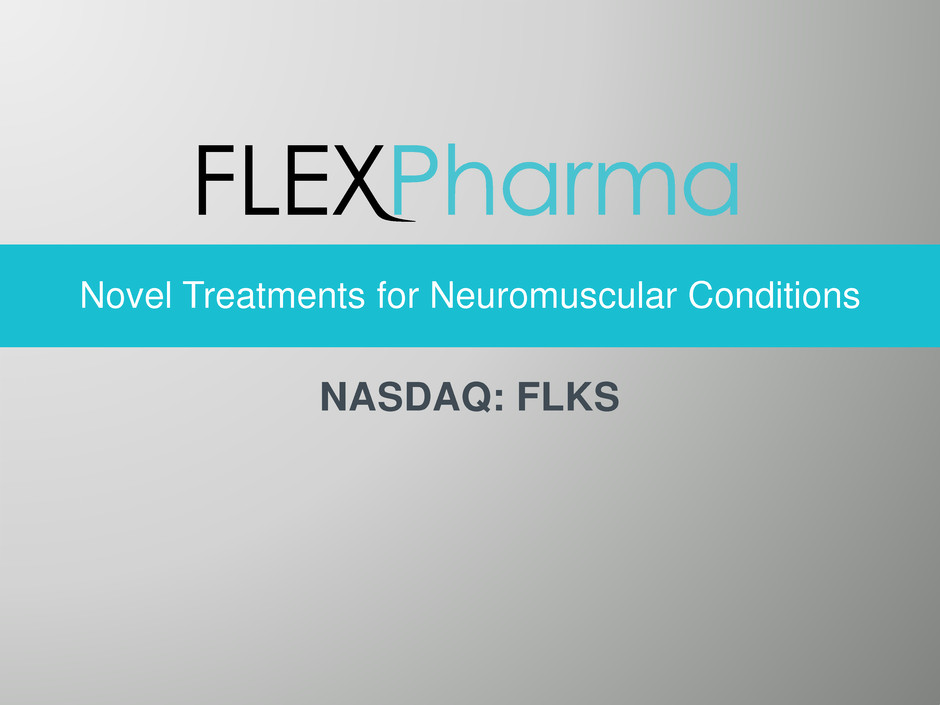Form 8-K Flex Pharma, Inc. For: Mar 26
UNITED STATES
SECURITIES AND EXCHANGE COMMISSION
Washington, D.C. 20549
FORM 8-K
CURRENT REPORT
Pursuant to Section 13 or 15(d)
of the Securities Exchange Act of 1934
March 26, 2018
Date of Report (Date of earliest event reported)
Flex Pharma, Inc.
(Exact name of registrant as specified in its charter)
Delaware | 001-36812 | 46-5087339 | ||
(State or other jurisdiction | (Commission File Number) | (IRS Employer Identification No.) | ||
of incorporation) | ||||
800 Boylston Street, 24th Floor Boston, MA | 02199 | |
(Address of principal executive offices) | (Zip Code) | |
Registrant’s telephone number, including area code: (617) 874-1821
Check the appropriate box below if the Form 8-K filing is intended to simultaneously satisfy the filing obligations of the registrant under any of the following provisions:
o Written communications pursuant to Rule 425 under the Securities Act (17 CFR 230.425)
o Soliciting material pursuant to Rule 14a-12 under the Exchange Act (17 CFR 240.14a-12)
o Pre-commencement communications pursuant to Rule 14d-2(b) under the Exchange Act (17 CFR 240.14d-2(b))
o Pre-commencement communications pursuant to Rule 13e-4(c) under the Exchange Act (17 CFR 240.13e-4(c))
Indicate by check mark whether the registrant is an emerging growth company as defined in Rule 405 of the Securities Act of 1933 (§230.405 of this chapter) or Rule 12b-2 of the Securities Exchange Act of 1934 (§240.12b-2 of this chapter).
Emerging growth company x
If an emerging growth company, indicate by check mark if the registrant has elected not to use the extended transition period for complying with any new or revised financial accounting standards provided pursuant to Section 13(a) of the Exchange Act. x
Item 8.01 Other Events.
On March 26, 2018, Flex Pharma, Inc. ("the Company") issued a press release announcing the topline data from its exploratory Phase 2 clinical trial of FLX-787 in Multiple Sclerosis patients with frequent muscle cramps/spasms and spasticity. The Company will host a conference call and live webcast with a slide presentation on Monday, March 26, at 8:45 a.m. EDT. A copy of this press release and slide presentation are filed herewith as Exhibits 99.1 and 99.2, respectively, and the information contained therein is incorporated by reference into this Current Report on Form 8-K.
Item 9.01 Financial Statements and Exhibits.
(d) Exhibits
Exhibit No. | Description | ||
99.1 | |||
99.2 | |||
SIGNATURES
Pursuant to the requirements of the Securities Exchange Act of 1934, the Registrant has duly caused this report to be signed on its behalf by the undersigned hereunto duly authorized.
Flex Pharma, Inc. | ||
Dated: March 26, 2018 | ||
By: | /s/ John McCabe | |
John McCabe | ||
Chief Financial Officer | ||

Flex Pharma Reports Positive Topline Data from Exploratory Phase 2 Trial of FLX-787 in Multiple Sclerosis
• | FLX-787 reduced cramp/spasm frequency (p=0.0017) and increased cramp-free days (p=0.0457) in MS patients in a pre-specified analysis of the parallel treatment phase |
• | Treating physicians reported improvement in spasticity in patients receiving FLX-787 as measured by the Clinical Global Impression of Change (CGI-C) in pre-specified analyses (p=0.01 parallel period, p=0.0427 both cross-over periods) |
• | FLX-787 was generally well tolerated with no treatment-related serious adverse events reported |
• | Conference Call Scheduled Today at 8:45 a.m. EST |
Boston, MA, March 26, 2018 - Flex Pharma, Inc. (NASDAQ: FLKS), a clinical-stage biotechnology company that is developing innovative and proprietary treatments for cramps, spasms and spasticity associated with severe neurological diseases such as multiple sclerosis (MS), Charcot-Marie-Tooth (CMT) and amyotrophic lateral sclerosis (ALS) under FDA Fast Track designation today announced positive topline data for FLX-787 from its exploratory Phase 2 trial in MS patients with frequent muscle cramps/spasms and spasticity.
“MS patients frequently complain of cramps, spasms, and spasticity which can dramatically affect their quality of life.” said Anneke van der Walt, MBChB, FRACP, PhD. Associate Professor of Neurology, Royal Melbourne Hospital, University of Melbourne, Australia, and lead investigator of the study. “These new data suggest that FLX-787 may have the potential to address this important unmet medical need.”
FLX-787 at a dose of 19 mg, taken orally twice daily, in a liquid formulation was evaluated in an exploratory Phase 2 randomized, double-blinded, placebo-controlled, cross-over trial in 57 MS patients.
In the evaluation of FLX-787 for its impact on MS patients’ cramps/spasms and spasticity, pre-specified analyses of the parallel portion of the study showed:
• | A statistically significant 27.3% reduction in the frequency of cramps/spasms compared with control (p=0.001) |
• | A 1.4 day increase in cramp/spasm-free days per 14 day period compared with control (p=0.0457) |
• | Clinician-rated improvement in spasticity with FLX-787 treatment was significantly better than control (p=0.01) |
• | Treating physicians reported that 7 of 28 (25%) patients on FLX-787 had “Much Improved” or “Very Much Improved” spasticity versus 0 of 26 (0%) on control based upon the Clinical Global Impression of Change in Spasticity |
In the evaluation of FLX-787 from data that included both cross-over periods in the intent-to-treat (ITT) population:
• | The pre-specified analysis of Clinical Global Impression of Change (CGI-C) in the patient’s spasticity showed statistically significant greater improvement with FLX-787 relative to control (p=0.0427) |
• | No statistically significant improvement was seen in cramp/spasm frequency, NRS or clinical spasticity scales |
FLX-787 was generally well tolerated and resulted in no drug-related serious adverse events. GI-related adverse events (diarrhea and nausea) were infrequently reported with FLX-787.
“We see in these data the clear potential of FLX-787 to improve cramps and spasticity in patients with MS,” stated William McVicar, PhD., Flex Pharma President and CEO. “Based upon these strong data and the learnings from this study, we look forward to the development and execution of a refined phase 2b study as part of our full FLX-787 clinical development program.”
“Late last year, FLX-787 demonstrated a similar efficacy profile in a small exploratory study of ALS patients. Our MS trial results provide a second set of clinical evidence that FLX-787 may provide beneficial activity in patients with underlying neurological disease and demonstrates the potential of chemical neurostimulation in treating symptoms arising from motor neuron and reflex hyperexcitability,” said Flex Pharma Chief Medical Officer Thomas Wessel, M.D., Ph.D.
Data from this study outlined above will be presented at future medical meetings.
Conference Call & Webcast Information
The Flex Pharma management team will host a conference call and live webcast with slides with the investment community today, Monday, March 26, at 8:45 am EST to discuss the information in this press release.
Date: Monday, March 26, 2018
Time: 8:45 am EST
Dial-in: 855-780-7202
Replay: 855-859-2056
Conference ID: 1476389
The live webcast and accompanying slides can be accessed under the investor relations section of Flex Pharma’s website at www.flex-pharma.com. A replay of the conference call will be archived under the investor relations section of the Flex Pharma website for three months after the call.
About FLX-787
FLX-787 is an orally disintegrating tablet that is designed to treat cramps, spasms and spasticity associated with severe neurological conditions including ALS, MS and peripheral neuropathies such as Charcot-Marie-Tooth (CMT). FLX-787 is a novel dual transient receptor potential A1/V1 (TRPA1/V1) ion channel activator designed to dampen the underlying hyperexcitability of spinal circuits responsible for cramps, spasms and spasticity. It has shown significant inhibition of electrically-induced muscle cramps (EIC), nocturnal leg cramps (NLC) in healthy adults and cramps in ALS patients. FLX-787 is being developed under Fast Track designation for the treatment of severe muscle cramps associated with ALS.
About Flex Pharma
Flex Pharma, Inc. is a clinical-stage biotechnology company developing innovative and proprietary treatments in Phase 2 randomized, controlled trials for cramps, spasms and spasticity associated with the severe neurological conditions of ALS, MS and peripheral neuropathies such as Charcot-Marie-Tooth (CMT). The Company’s lead candidate, FLX-787, is being developed under Fast Track designation for the treatment of severe muscle cramps associated with ALS.
Forward-Looking Statements
This press release contains forward-looking statements for purposes of the safe harbor provisions of the Private Securities Litigation Reform Act of 1995. These forward-looking statements include statements regarding our intentions, beliefs, projections, outlook, analyses or current expectations concerning, among other things: the progress, timing, scope and results of ongoing and anticipated clinical studies. These forward-looking statements are based on management's expectations and assumptions as of the date of this press release and are subject to numerous risks and uncertainties, which could cause actual results to differ materially from those expressed or implied by such statements. These risks and uncertainties include, without limitation: the status, timing, costs, results and interpretation of our clinical studies; the uncertainties inherent in conducting clinical studies; results from our ongoing and planned preclinical development; expectations of our ability to make regulatory filings and obtain and maintain regulatory approvals; our ability to successfully commercialize our consumer product; results of early clinical studies as indicative of the results of future trials; availability of funding sufficient for our foreseeable and unforeseeable operating expenses and capital expenditure requirements; other matters that could affect the availability or commercial potential of our consumer or drug product candidates; and the inherent uncertainties associated with intellectual property. Other factors that may cause actual results to differ from those expressed or implied in the forward-looking statements in this press release are discussed in our filings with the U.S. Securities and Exchange Commission (SEC), including the "Risk Factors" contained therein. You are encouraged to read our filings with the SEC, available at www.sec.gov, for a discussion of these and other risks and uncertainties. Any forward-looking statements that we make in this press release speak only as of the date of this press release. We assume no obligation to update our forward-looking statements whether as a result of new information, future events or otherwise, after the date of this press release.
Source: Flex Pharma, Inc.
Investors
Elizabeth Woo
617-874-1829
SVP, Investor Relations & Corporate Communications
Flex Pharma, Inc.
Media
Sophia Ononye
Medical Dynamics
1-212-537-9495

FLEX-201: Exploratory Study of FLX-787 in
Multiple Sclerosis Patients
NASDAQ: FLKS
March 2018

2
Any statements in this presentation and the oral commentary about future expectations, plans and prospects for the company, including statements
about the company’s strategy, future operations, ongoing clinical trials, development of its consumer and drug product candidates, plans for potential
future product candidates and other statements containing the words “anticipate,” “believe,” “estimate,” “expect,” “intend,” “may,” “plan,” “predict,”
“project,” “suggest,” “target,” “potential,” “will,” “approximately,” “development plans,” “would,” “could,” “should,” “continue,” and similar expressions,
constitute forward-looking statements within the meaning of The Private Securities Litigation Reform Act of 1995. Actual results may differ materially
from those indicated by such forward-looking statements as a result of various important factors, including: the status, timing, design, costs, results
and interpretation of the company’s clinical studies; the uncertainties inherent in conducting clinical studies; results from our ongoing and planned
preclinical development; expectations of our ability to make regulatory filings and obtain and maintain regulatory approvals, our ability to commercialize
our consumer products; positioning and product attributes of our consumer products; results of early clinical studies as indicative of the results of
future trials; availability of funding sufficient for the company’s foreseeable and unforeseeable operating expenses and capital expenditure
requirements; other matters that could affect the availability or commercial potential of the company’s consumer or drug product candidates; the
inherent uncertainties associated with intellectual property; and other factors discussed in the Risk Factors set forth in the company’s Annual Report
on Form 10-K filed with the Securities and Exchange Commission (SEC) and in other filings the company makes with the SEC from time to time. We
may not actually achieve the plans, intentions or expectations disclosed in our forward-looking statements, and you should not place undue reliance on
our forward-looking statements. The forward-looking statements in this presentation represent our views as of the date of this presentation. We
anticipate that subsequent events and developments will cause our views to change. However, while we may elect to update these forward-looking
statements at some point in the future, we have no current intention of doing so except to the extent required by applicable law. You should, therefore,
not rely on these forward-looking statements as representing our views as of any date subsequent to the date of this presentation.
This presentation also contains estimates and other statistical data made by independent parties and by the company relating to market size and
growth and other data about the company’s industry. This data involves a number of assumptions and limitations, and you are cautioned not to give
undue weight to such estimates. In addition, projections, assumptions and estimates of the company’s future performance and the future performance
of the markets in which the company operates are necessarily subject to a high degree of uncertainty and risk.
This presentation contains references to our trademarks and to trademarks belonging to other entities. Solely for convenience, trademarks and trade
names referred to in this presentation, including logos, artwork and other visual displays, may appear without the ® or TM symbols, but such
references are not intended to indicate, in any way, that their respective owners will not assert, to the fullest extent under applicable law, their rights
thereto. We do not intend our use or display of other companies' trade names or trademarks to imply a relationship with, or endorsement or
sponsorship of us by, any other companies.
Forward-Looking Statements

3
Electrically-induced
cramp model for:
Origins of FLX-787: A Single Molecule, Dual
TRPV1/A1 Activator
2014 2015 2016 2017 2018
Compositional Analysis
Numerous TRP activators
Isolation of single-agent dual
TRPA1/V1 activator, FLX-787
Synthetic pharmaceutical
grade FLX-787
Formulation of FLX-787
as an orally disintegrating
tablet
US IND open
Well-controlled
studies in severe,
neurodegenerative
diseases
Original
Proprietary
Extract
Formulation
Flex
R&D
Optimized
Consumer Beverage

4
MOA for Topical Modulation of the CNS by FLX-787:
Stimulation-Processing-Motor Output
Sensation
Alpha-motor neurons
connecting to muscle
Spinal cord
Descending
Inhibitory
Pathway
Nerves
Central processing in
brainstem leads to
inhibition through
descending fibers in spinal
cord
Sensory neurons with
TRPA1/V1 channels
stimulated by FLX-787
Descending inhibition
reduces: 1) alpha-motor
neuron hyperexcitability
halting muscle cramps and
2) reflex hyperexcitability
attenuating spasticity
1
2
3

5
Objectives and Design:
• Explore the potential of chemical neurostimulation with FLX-787 to improve
spasticity and decrease cramps/spasms in patients with MS
• Determine the patient characteristics and study design most sensitive to observed
clinical improvements by FLX-787 for incorporation into future regulatory trials
Study Design:
• A multi-center trial studying MS patients suffering from spasticity and
cramps/spasms
• A randomized, double-blind, placebo-controlled, 14-day per period crossover study
• Evaluated the effects of FLX-787 across multiple MS-associated endpoints
including muscle cramp/spasm frequency and spasticity
• Assessed the efficacy of FLX-787 when self-administered BID as an oral solution
containing 19 mg
Exploratory MS Study: Proof of Concept
FLX-787
FLX-787Inactive Control
Inactive
Control
Run-in
Placebo
Washout

6
Multiple Signals of Biological Activity:
In pre-specified analyses of the parallel portion of the study, anti-
cramp/spasm and anti-spasticity activity was observed:
• 27.3% decrease in Cramp/Spasm Frequency (p=0.001)
• 1.4 day increase in Cramp-free Days (p=0.0457)
• Treating physicians reported that 7 of 28 FLX-787 patients had
“Much Improved” or “Very Much Improved” spasticity versus 0 of 26
on Control (Clinical Global Impression of Change in Spasticity)
Successful Exploratory MS Study Showing FLX-787
Activity Across Multiple MS-Associated Endpoints

7
• In a pre-specified analysis that included both cross-over periods, a
significant anti-spasticity effect was observed with FLX-787, when
compared to Control, as measured by CGI-C for spasticity (p=0.0427)
- CGI-C Responders (defined as “Much Improved” or “Very Much
Improved”) were more prevalent on FLX-787 (N=13/54) versus control
(N=2/52) (p=0.004, post-hoc analysis)
• No statistically significant improvement in cramp/spasm frequency, NRS or
clinical spasticity scales from data that included both cross-over periods
(ITT)
Successful Exploratory MS Study Showing FLX-787
Activity Across Multiple MS-Associated Endpoints

8
• FLX-787 at doses up to 19 mg (BID) in an oral solution was generally well
tolerated
• No treatment-related SAEs occurred during the study
• The most-commonly reported AEs with FLX-787 were GI-related, mild to
moderate, and self-limiting
• 2 subjects (1 Control; 1 Placebo) and 3 FLX-787 subjects discontinued the
study due to an adverse event
• No clinically relevant laboratory, vital signs or ECG abnormalities were
noted
Summary of Safety

9
• Cross-over design studies typically have more power to compare within
patients but can be subject to confounding factors
• Specifically, FDA has identified the following concerns that could impact the
interpretation of cross-over studies with FLX-787:
- Carryover effects
- Drop-outs, especially between periods
- Unblinding
- Sequence and period effects
- Learning effects which may be different in each period
- Interpretability of results from the second period
Parallel Period Analysis Simulates Blinded Parallel
Group Design Without Cross-over Limitations
FLX-787
FLX-787 Inactive Control
Inactive
Control
Run-in
Placebo
Washout
Parallel Period of Study

10
• In pre-specified Parallel Period Analyses, FLX-787 decreased the number
of Cramps/Spasms and increased Cramp-free Days (changes from baseline
in cramp/spasm population, over a 14-day treatment period)
• The results from data that included both cross-over periods were not
statistically significant
FLX-787 Significantly Decreased Cramps/Spasms and
Increased Cramp-free Days
Efficacy Endpoint FLX-787 Control p-value
Change in Cramp/Spasm
Frequency -9.7 2.9 0.0017
%Change in Cramp/Spasm
Frequency -27.3% 14.2% 0.0010
Change in Cramp Free Days 1.4 0.0 0.0457
Table 14.2.1.29.2.c

11
• 7/28 (25%) on FLX-787 vs 0/26 (0%) on Control were judged by the treating
physician as “Much Improved” or “Very Much Improved”
• Comparison of the proportions with Fisher’s exact test confirmed this difference to
be statistically significant (p=0.01)
FLX-787 Improved Spasticity by CGI-C
(Parallel Period Analysis)
Score Placebo
(Run-in, n=57)
FLX-787
(n=28)
Inactive Control
(n=26)
Very Much Improved (1) 0 (0%) 0 (0%) 0 (0%)
Much Improved (2) 0 (0%) 7 (25%) 0 (0%)
Minimally Improved (3) 6 (11%) 10 (36%) 6 (23%)
No Change (4) 35 (61%) 7 (25%) 10 (38%)
Minimally worse (5) 12 (21%) 3 (11%) 10 (38%)
Much Worse(6) 3 (5%) 1 (4%) 0 (0%)
Very Much Worse (7) 1 (2%) 0 (0%) 0 (0%)
p=0.01
Clinicians were asked to “rate total improvement of Spasticity and whether or not, in your clinical
judgement, it is due entirely to drug treatment”.
CGI-C
Responders

12
Score Placebo
(Run-in, n=57)
FLX-787
(n=54)
Inactive Control
(n=52)
Very Much Improved (1) 0 (0%) 1 (2%) 0 (0%)
Much Improved (2) 0 (0%) 12 (22%) 2 (4%)
Minimally Improved (3) 6 (11%) 14 (26%) 18 (35%)
No Change (4) 35 (61%) 19 (35%) 18 (35%)
Minimally worse (5) 12 (21%) 5 (9%) 12 (23%)
Much Worse(6) 3 (5%) 3 (6%) 1 (2%)
Very Much Worse (7) 1 (2%) 0 (0%) 1 (2%)
Source: Table 14.2.1.29.1.a, 14.2.1.23a, file 2018-03-18_ivrsnumtabCA17071_stat)
FLX-787 Improved Spasticity by CGI-C
(Both Crossover Periods)
Clinicians were asked to “rate total improvement of Spasticity and whether or not, in your clinical
judgement, it is due entirely to drug treatment”.
p=0.0427
CGI-C
Responders

13
FLX-787 Reduced Cramps/Spasms in First
Treatment Exposure Anaysis
Run-in 1st Crossover 2nd Crossover
35.1
Δ+2.9
Control
Δ-5.0
FLX-787
20.5
Δ-9.7
FLX-787
Δ-1.6
Control
M
ed
ia
n
C
ra
m
p/
S
pas
m
F
re
qu
en
cy
FLX-787
Effect
FLX-787
Effect
Tables 14.2.1.1.2.c
p= 0.0003
To correct for baseline imbalance and potential sequence and temporal effects,
post-hoc analyses evaluated first exposure to drug, and change from previous
treatment as baseline (serial period analysis)

14
• Reduction in Cramp/Spasm Frequency
• Increase in Cramp-free Days
• Greater number of patients assessed with spasticity “Much Improved” or
“Very Much Improved”
• FLX-787 was generally well tolerated with minor GI side effects.
Based on this evidence of FLX-787-mediated biological activity in MS
patients, we are planning our Phase 2b program
Overall Summary: FLX-787 Improved
Cramps/Spasms and Spasticity in MS Patients

15
Longer run-in to account for disease variability
Longer treatment periods to allow greater time to achieve
maximal drug effect
Parallel treatment design
Increased dosing frequency (BIDTID)
Explore dose range (higher doses e.g.)
Use orally-disintegrating tablet with longer oral residence time
Optimized patient characteristics
Future Phase 2b MS Cramping and Spasticity Trial

Novel Treatments for Neuromuscular Conditions
NASDAQ: FLKS
Serious News for Serious Traders! Try StreetInsider.com Premium Free!
You May Also Be Interested In
- Meta shares dip on softer Q2 revenue guidance, elevated AI spending plans
- ISC2 Research Finds Some Progress, But More Needs to be Done to Support Women in Cybersecurity
- Escalade Reports First Quarter 2024 Results
Create E-mail Alert Related Categories
SEC FilingsSign up for StreetInsider Free!
Receive full access to all new and archived articles, unlimited portfolio tracking, e-mail alerts, custom newswires and RSS feeds - and more!



 Tweet
Tweet Share
Share